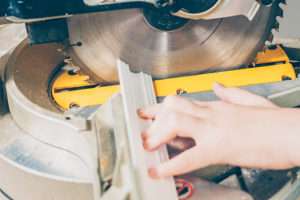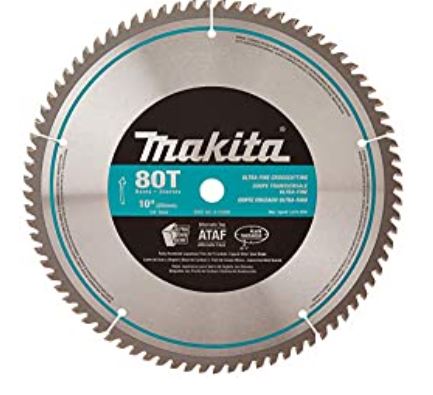This post may contain affiliate links which means I may receive a commission for purchases made through links.

Most miter saws for crown molding comes with general-purpose blades. For that, you might not get the desired results in your crown molding installation projects since the quality of your miter cuts solely depends on the type of miter saw blade you’re using. Moreover, regular miter saw blades become dull quite fast as they can’t withstand wear and tear, especially when used for tough applications.
Luckily, you can avoid these challenges by upgrading to the best miter saw blade for trim and crown molding. This will allow you to enjoy the smoothest miter cuts, compound angle cuts, and cross-cutting for your trim work, cabinet making, furniture building, and crown molding installation projects.
However, with so many types and sizes of miter saw blades in the market, how do you find the perfect one for your crown molding and trim work? Well, you just did! In this guide, I’ve reviewed the top 3 miter saw blades that are suitable for trim and crown molding projects.
But first, let’s look at the benefits of choosing the right type of miter saw blade for crown molding and some of the important factors you should consider!
Why should you choose the right type of miter saw blade for trim and crown molding?
In addition to improving the outcome of your work, choosing the right type and size of miter saw blade offers several benefits. For instance, a good quality miter saw blade makes an effective cut on your crown molding pieces or any material you’re working on. This will help you make cleaner and smoother cuts within a short duration.
At the same time, a miter saw blade that can smoothly slide or run on the material of your crown molding and trim will protect the motor of your miter saw from early damage. That’s because the motor tends to wear out quickly if it’s generating too much heat energy to forcibly run the blade through the material you’re cutting.
Lastly, a good working miter saw blade ensures safety throughout the operation of your tool.
Factors to consider when buying the best miter saw blade for trim and crown molding
There are various factors that miter saw experts when choosing a miter saw blade for trim and molding. Understanding these factors will help you narrow down the best miter saw blade for your projects. Some of the most important features include;
-
Miter saw blade size
Generally, the miter saw blade size refers to the diameter of the blade. There are various sizes of miter saw blades ranging from 5 to 15”. 8”, 10”, and 12” are the most popular sizes, although smaller trim saws usually use 7.25” or 8.5” blades. For that, it’s important to ensure that you have selected the right blade size for your crown molding miter saw since there is no one size fits all.
Luckily, miter saws are usually marketed with the size of the blade. For instance, a 10” miter saw requires a blade with a diameter of 10”.
The most commonly used blade sizes for crown molding are 10” and 12” blades. In most cases, a 10” miter saw blade will get the job done. However, if you intend to cut thicker materials, you might need a 12” blade since the blade only cuts objects half its diameter. Therefore, a 10” blade has a maximum cutting depth of 5”. So, if you want to make cuts that are deeper than 5”, you’ll need a 12” blade.
-
Number of teeth
You will also note that miter saw blades have different numbers of teeth, ranging from about 14 to 120 teeth. The number of teeth on a blade determines the type of cut and material you should use it on. For instance, the more teeth the miter saw blade has, the finer and smoother the cut will be.
In this case, since you’re looking for a miter saw blade that will help you make clean cuts in trim and molding, choose a blade with about 80 teeth. This will help you make cleaner, smaller, and more precise cuts at a slower speed, thus reducing the chance of burning your crown molding material.
It’s also worth mentioning that a larger blade requires more teeth compared to a blade with a smaller diameter. So, if you want to do cross cuts with a miter saw, choose a tool with at least 70 teeth for the 10” blade and 80 teeth for the 12” blade. However, if you want to get smooth cuts, you can choose blades with more teeth.
-
Construction
Miter saw blades are usually made from steel, which allows them to cut through various materials such as stone, metal, ceramic, and wood. Unfortunately, steel blades tend to become dull after limited use. For that reason, their teeth/ tips are crafted with other materials that last longer.
Two of the most commonly used materials for miter saw blade tips/ teeth are carbides and High-speed steel (HSS). Carbide is the most preferred material since it stays sharp for a much longer time than high-speed steel. The only issue with carbide-tipped miter saw blades is that they can be a bit pricey. So, if you’re looking for an affordable miter saw blade, look for an HSS miter saw blade.
Apart from carbide and high-speed steel, some blades are diamond tipped, allowing them to handle both wood and masonry work. However, such blades are commonly used in professional settings as they’re even more costly than carbide-tipped blades.
-
Arbor/ Bore size
Arbor size refers to the diameter of the hole in the center of a miter saw blade. Before you settle on a particular blade, it’s important to ensure that its arbor size is compatible with the crown molding miter saw. Most 10” miter saws have a ⅝” arbor, while 12” miter saws have a 1” arbor. However, make sure you check your miter saw’s arbor size before you buy any blade.
If the bore/ arbor size is too small, the blade will wobble and vibrate during use, which can damage your saw and cause kickback. Contrarily, if the bore size is too large, the blade will not fit properly on your miter saw.
-
Kerf Width
In a miter saw blade, Kerf refers to the width of the cut that the tool will make, usually measured in millimeters. For most molding and trim applications, avoid using a blade with a large kerf width. Instead, the best miter saw blade for trim and molding should have a kerf width of around 2 mm. A thinner miter saw blade reduces chipping and allows for a more precise cut.
3 Best Miter Saw Blades for Trim and Crown molding
1. Makita A-93681 10” 80-Teeth Miter Saw Blade
First on the list is the Makita A-93681, which is a great option for anyone looking for an affordable miter saw blade for trim and crown molding. The blade is crafted from high-quality carbide steel. Plus, it has 80 micro-grain carbide teeth that are hand tensioned and hardened to create a precise and durable cutting tool.
Another interesting feature about this blade is that it has a thin knife design, seeing that its kerf width is just .091 kerf width. As a result, it creates highly accurate cuts and smooth cross cuts, while wasting minimal amounts of material. Moreover, this cutting tool has a unique tooth design that reduces splintering and chipping.
The only issue with this miter saw blade is that it creates a loud whistling sound. Other than that, this 10” blade is compatible with most types of crown molding miter saws.
Highlighted Features
- Ideal for plywood, softwood, and hardwood
- 5 deg hook angle and .071 plate thickness
- Laser-cut plate to deliver clean & precise cuts
- 80 Micro-grain carbide teeth
Drawbacks
- Produces a high-pitched whistle during use
2. Diablo D1080X ATB Miter Saw Blade
Diablo is a reputable brand in the miter saw blade industry as their products are well-crafted. One such product is this 10” ATB miter saw blade for crown molding which has been laser cut and ground smooth to deliver maximum performance during use. More importantly, it has 80 teeth, making it a great5 cutting tool for making cross cuts on trim and molding.
In addition, this miter saw blade comes with Diablos Patented laser-cut stabilizer vents. This helps to reduce vibration and noise during use while increasing its accuracy.
In terms of construction, the blade teeth are made from TiCo Hi-Density carbide, which allows it to withstand extreme impact for maximum longevity. More importantly, the carbide cutters are attached to the blade plater through a tri-metal brazing process. This process involves sandwiching a layer of copper alloy between silver alloy layers to provide extra flexibility as well as impact resistance.
As if that’s not enough, the blade is then coated with a perma-shield non-stick layer to protect it from heat, corrosion, and gumming. Better yet, its steel body is hardened, giving it a sharper cutting edge and longer life.
Highlighted Features
- Super thin laser cut kerf for clean and precise cuts
- Laser-cut stabilizer vents
- Laser cut ⅝” arbor/bore size
- Compatible with table and miter saws
Drawbacks
- Cuts a bit slower than other miter saw blades
3. FREUD D12100X Miter Saw Blade Saw Blade
Like the miter saw blade above, this FREUD cutting tool comes from Diablo. However, it has a diameter of 12” and 100 teeth, instead of 80. This makes it a great blade for fine-cutting trim and crown molding.
In addition, this high number of teeth provides a smooth cut and prevents the surface from burning due to a slow feed time. More notably, this larger size makes it a great tool for most professional settings where you need clean cuts on the first pass. Not to forget that it can easily cut through several types of hardwoods.
Even better, this miter saw blade features a laser-cut kerf. As a result, it produces the same smooth cuts as those produced by 120-grit sandpaper.
Moving on, this blade has a unique Parma-Shield coat to protect it from rust and corrosion. At the same time, this coating protects the tool against heat and prevents gumming. Moreover, its teeth are made from high-density carbide, allowing them to stay sharper longer.
On the downside, this miter saw blade is a bit pricey compared to other tools on the list. In addition, it’s not ideal for use on softer woods as it can leave rough cuts on softwoods.
Highlighted Features
- Laser-cut stabilizer vents to reduce noise & vibration
- 100 high-density carbide teeth
- Parma-shield rust-proof non-stick coating
- 12” diameter
- 1” arbor size
Drawbacks
- A bit costly
Conclusion
Choosing the right miter saw blade will help you perform your crown molding and trim projects to the best of your ability. Thankfully, as you’ve seen, there are some incredible options out there. Best of all, these cutting tools are specifically designed to provide better performance and last longer for several crown molding projects to come!



